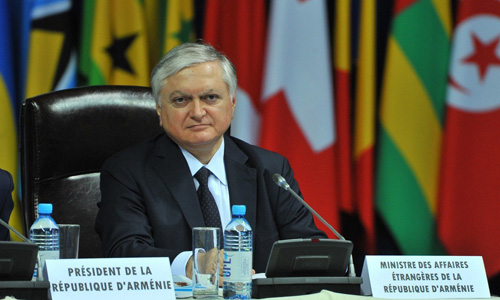YEREVAN — The United States Agency for International Development (USAID) and the Smithsonian Institution have partnered for an innovative project to support cultural sustainability through cultural tourism in Armenia.
The project was launched on Friday, November 20 during an official ceremony at the Matenadaran Scientific Research Institute of Ancient Manuscripts in Yerevan, which holds one of the world’s richest collections of medieval manuscripts and books.
At the event, the U.S. Ambassador to Armenia Richard Mills, Jr., Prime Minister Hovik Abrahamyan, and the Senior Advisor of the Smithsonian’s Office of International Relations, Halle Butvin delivered remarks. About 100 people attended the event, including Government members, private sector and the tourism industry representatives.
The four-year project, funded by USAID, aims to enhance and increase cultural heritage tourism in the regions outside Armenia’s capital Yerevan, through a unique combination of research, scholarship, support for artisan craft, capacity building, and a strong focus on fresh thinking for tourism development.
“The global tourism market continues to grow and cover new destinations. Armenia’s rich cultural heritage, unique cuisine, beautiful natural environment and welcoming people make it a special place,” said Ambassador Mills. “The purpose of “My Armenia” project is nothing less than to put Armenia on the map as a world-class tourist destination. We intend to not only contribute to the development of the tourism industry in Armenia, but also ensure that the benefits of that growth are widely distributed across the country by promoting tourism to regions outside of Yerevan, thus enhancing the economic prospects of Armenia’s rural communities.”
The Smithsonian has a long history of working with communities around the world to support efforts in cultural sustainability, whether protecting cultural heritage threatened by human conflict and natural disaster, or supporting the long-term sustainability of diverse cultural sectors.
Through training, programming, community engagement and documentation, and other methods, Smithsonian curators and project staff from across the Institution will work with partners in Armenia to develop new strategies for sustaining cultural heritage.
This project will support traditional arts, crafts and music in the country and lead to greater benefits for rural communities in Armenia, broader awareness about Armenia in international markets, as well as help protect and enhance Armenia’s natural and cultural heritage.
“Tourism can be a driver of economic development by generating employment in hotels and restaurants, as well as increasing business for taxi drivers, those making and selling souvenirs, or those providing goods and services to tourism-related businesses,” Ambassador Mills said. “However, to spread the wealth generated by tourism, Armenia needs to develop anchor tourism sites outside of Yerevan and link them together in a tourism circuit that spans the length and breadth of the country. This new project will provide technical assistance to develop such a circuit, which will encourage travelers to travel outside of Yerevan and spend more money in the regions. This is just one of the many ways the U.S. Embassy is partnering with the Armenian people to strengthen the economy of Armenia’s rural regions.”
The Smithsonian has a long history of working with USAID on international programming to support the conservation of biodiversity, museum workforce capacity building, and emerging cultural institutions. Reflecting a renewed partnership between the two organizations established through a 2013 Memorandum of Understanding, the “My Armenia” project signifies a new, collaborative approach to combine the strengths of the two organizations for greater impact.










